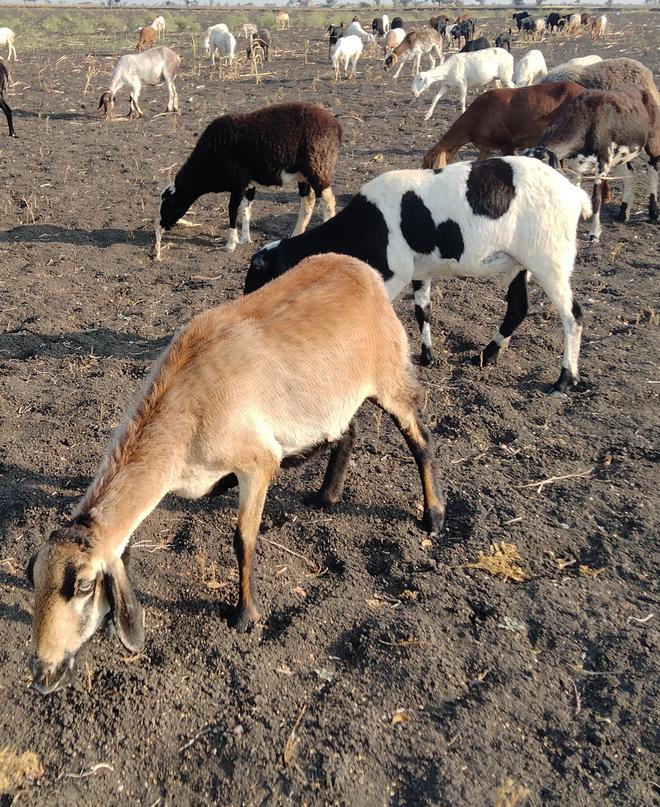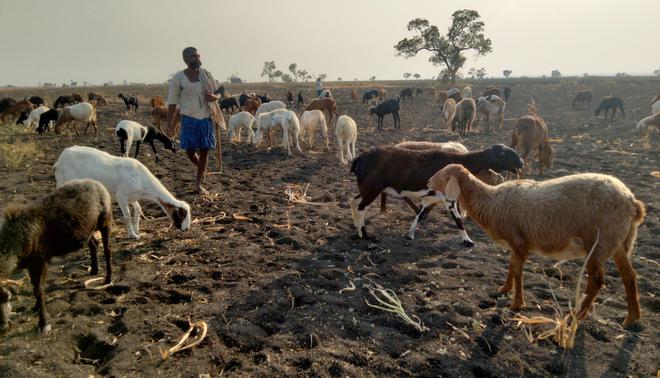A group of young men are crossing a grassland with a small herd of sheep in Khavarevasti near Nippani on the Karnataka- Maharashtra border. They are coming from Balu Mama temple in Adamapur near Kolhapur. They decide to rest for a while. They let the sheep graze while they set up a stone stove under a tree. Lunch is rice and a sambar made from onion and brinjal, chilli and fresh sheep milk.
The milk is added just when the vegetables are boiled and taken off the stove. “If you cook even for one more minute, the milk gets spoilt,” explains Mallappa, who is in charge.
The flock is considered sacred by Mallappa and his clan as they include two “descendants” of the 15 sheep that were reared by Sant Balu Mama, a saint who lived in the late 19th century to early 20th century. Volunteers maintain the about 60,000 “Balu Mama sheep” that are constantly moving. The temple trust gives away male sheep but keeps the females. The keepers claim that they have been maintaining the gene pool of the Dakhani sheep intact for the next generations. A shepherd’s herd, like that of Mallappa, may have one or two sheep from this line, which the sherpherd regards “auspicious” and “lucky”.
These herds are a common sight for travellers between Karnataka and Maharashtra. Devotees of Balu Mama travel from as far as Andhra and walk to the temple, along with their sheep. Born in Akkol near Chikkodi, Balu Mama lived in Adamapur where his Samadhi was built. The saint who lived in the British era is supposed to have practised native medicine that cured sheep. He has innumerable devotees, who do not object even if the Balu Mama sheep flock enters standing crops in their fields and eats them.
Similar devotion is seen in Bommagonda, a shepherd in the Bidar district, who is believed to have lobbied with the Behmani Kings who made sheep and wool trade tax-free in the 15th century. Statues and images of Bommagonda with two sheep and a dog, are found across the districts of Bidar and Kalaburagi.
The stories of these saints are distinct from those of saint poet Kanaka Dasa of Haveri district or Sharana Gollaleshwara of Vijayapura district, from the Kuruba community, who are known for their spiritual pursuits.

How many in North Karnataka
There are over an estimated 90 lakh sheep in northern Karnataka. “The live stock: A study” by the Food and Agriculture Organisation in 2004 put the figure at 76 lakhs.
It is estimated that over 7.5 lakh families in the Deccan region depend on sheep rearing. But not all of them are Kurubas. They can belong to castes and ethnic groups like Gollas, Kurmas, Lambadas and Dalits in Andhra Pradesh; Kurubas, Kadu gollas, Lamanis, Bedars, Gollas and Dalits in Karnataka; Dhanghars, Kurubas and Dalits in Maharashtra; and Kurubas in Tamil Nadu. Some of these groups are traditional sheep rearers while others have taken up sheep-raising more recently.
“Poverty and landlessness makes people enter shepherding, and prosperity makes them leave it,’‘ says G. Gopi Krishna, one of the authors of the FAO study. He is also involved in organising and training shepherding groups, mentoring designers and master trainers and helping groups get markets in India and overseas.
Kurubas are the traditional sheep keepers in the northern Karnataka districts of Belgaum, Bagalkot, Koppal, Dharwar and Haveri and others. They are are semi-nomadic, moving with their flocks for between three to nine months a year. They may also take on lease some land for part of the year to grow crops such as sorghum, wheat, maize, oil seeds, minor millets and cotton. However, in some places , due to increasing prosperity, they are joining the class of landed gentry.
Many of the sheep rearers are also members of village cooperative societies. There are an estimated 5,000 such societies in the Deccan, most of them in Maharashtra and Karnataka. Most are into collecting deposits and lending. But there are a few unique institutions like the Belagavi-based Jagruta Kurubara Kuri Mattu Unne Utpadakara Sangha that has been involved in training and awareness campaigns like vaccination, nutrition, value addition for wool products and women’s empowerment. The society was started in 1990 after the rinderpest epidemic of 1989.
Neelkanth Mama of Uchagaon, who founded the JKKMUUS society along with nine others, says he is not very happy with the cooperative movement. “Over 90% of the societies are involved in money lending. We had expected them to graduate to institutions that took all round care of shepherds,’‘ he said. “A state level federation of sheep producers societies established a few years ago is yet to function effectively,’‘ a member of a local society in Bagalkot said.

What is produced
The sheep of the Deccan produce a range of products and services. The most important, but least regarded is manure and tillage. Farmers welcome shepherds and their flocks onto their fields during the fallow period, as the sheep eat weeds and other vegetation, and leave behind manure and urine that fertilizes the soil. This process is called penning. The animals’ hooves also break up clods of earth and help prepare the soil for planting. Farmers pay up to rupees three per sheep per day for penning. Rarely, it works on barter when shepherds collect grains after harvest.
During the monsoon from July to September, the shepherds move their animals to an area with lower rainfall and pen them in fields, where they collect manure to sell.
The shepherds sell male lambs aged 3–6 months at a weight of 10–18 kg in weekly livestock markets. An animal may cost between ₹3,000 to ₹6,000 depending on the weight and build of the animal. Shepherds sell the females after around 10 lambing cycles.
Sheep are sheared twice a year, before winter (in October or November) and before the monsoon (in April or May). A sheep may produce 250–500 grams of coarse wool. Men shear while women sort in two grades: lamb wool and adult wool. About one-quarter of the fleece is fine, good quality wool whose fibre is suitable for spinning. Another quarter of the fleece is very coarse which is used for making kamblis and caps.
The Dakhani sheep is famed for its wool. In fact, it is the only naturally evolved animal with wool that can be sheared in an economically feasible manner. Contrary to popular perception, wool comes in seven natural colours- shades of white, black and brown. Most shepherds shear their own animals using scissors, though some work is outsourced to a sub community called Katrigars.
The shepherds milk their animals and make buttermilk and butter, mostly for use in the breeder’s family. These products are usually not sold, but given to lactating mothers, infants and the sick, free of cost.
How market works
The demand for meat and hence the price, has increased exponentially. But the price of other materials has remained steady for over a decade. The prime reason for this is the beef ban imposed in some states like Karnataka.
“The increasing market for meat, the hard work involved in shearing, and the low prices for wool and penning, have forced farmers to shift to towards wool-less sheep. This has led to a disproportionately high demand for lambs. Earlier, shepherding families sold lambs after six months of birth. Now, they are selling after 2-3 months. It has affected the yielding cycle. Earlier a mother sheep conceived once every year. But now they are littering 3-4 lambs in two years. These are bound to be weaker and leaner,’‘ said Neelkanth Mama.
Other problems include hybridisation that has altered the character of native sheep, and allowing imports of shoddy wool, the fibre recovered from waste blankets and jackets from U.S.A. and Europe. Some state governments are also promoting breeds like the Red Nellore, Yelgu and Madgiyal aimed at producing meat rather than wool. As a result of these trends, the pure bred Dakhani has been in decline.
Hand holding by NGOs
The Shramik Abhivrudhi Sangh (SAS), an NGO that has been working in the area since the 1990s recognised the need to conserve the Dakhani breed. SAS project that began in 1996 helped local women produce and market bags and other handicrafts made of jute and cotton fibre. The women were trained in modern product design by a team of designers headed by Varsha Rani, a design faculty from JD institute of fashion and Rashmi Shivakumar.
Future Greens, a Bagalkot-based NGO, has been promoting farmer producing organisations among shepherding groups. A team led by veterinarian Balu Athani has promoted 26 FPOs in a decade. “We are working with small and marginal farmers, shepherds and goat keepers in rural areas to form producer companies to initiate them into collective businesses,’‘ said Dr. Athani who has worked in the Veterinary college Bidar and Karnataka Milk Federation earlier. “The group now has four brands available in Bengaluru, Mumbai and other cities -Simply Satwik, Nutriswad and Living Lite. We are launching the meat brand Nomadic Bytes soon,’‘ he said.
Demands of shepherds
The shepherds community says its demands are long pending as successive governments at the centre and state have neglected them. The demands include comprehensive insurance cover for sheep and shepherds, establishment of veterinary hospitals in villages and remote areas, universal vaccination and health care services, formal markets for non-meat products and a subsidy for penning as farmers are unable to pay higher prices.

They also demand policy changes in the import policy. “While Marino sheep imports can be regulated by higher taxation, import of used fabric and shoddy wool should be completely curbed,’‘ said Neelkanth Mama.
He also opposes indiscriminate hybridisation as it affects native breeds. “A few decades ago, some Indian universities and NGOs began promoting the NARI Suvarna breed that has the Fecundity- B gene that can produce twins, thinking it will help farmers increase their income. But we had a very bad experience as the mother is unable to feed two at once, due to scarcity of green grass.” Gopi Krishna adds that the army and central and state police should go back to using native wool blankets, rugs, jackets and gloves instead of using imported woollen goods. “Till the 1980s, farmers shipped to Panipat, over 10 goods trains full of local wool from the Hubballi railway station. But the centre allowed import of Marino wool and shoddy wool.”







